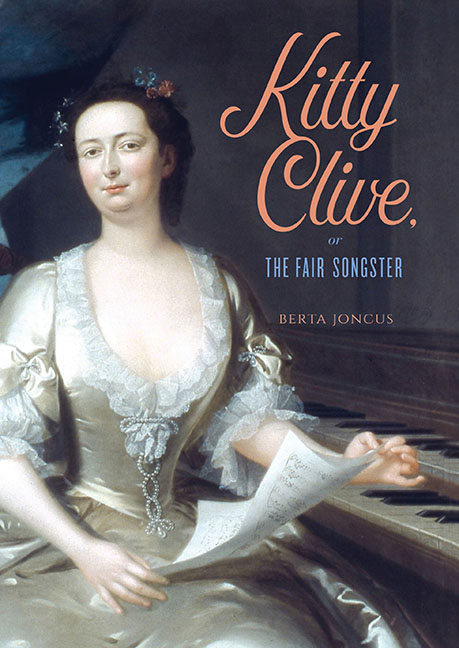Book contents
- Frontmatter
- Dedication
- Contents
- Illustrations
- Preface
- Conventions of Transcription
- 1 The Siren Song: Kitty Clive in the Playhouse
- 2 ‘The Lovely Virgin tun'd her Voice’: Henry Carey and the Production of a Native Songster
- 3 ‘Charm'd with the sprightly Innocence of Nell’: The Metamorphosis of Miss Raftor
- 4 ‘HINT writes, and RAFTOR acts in Drury-lane’: Clive, Fielding, and Theophilus Cibber
- 5 ‘The pious Daughter, and the faithful Wife’: Fielding, Miller, and Clive, 1733–35
- 6 ‘A Likeness where none was to be found’: Contested Images of Clive, 1734–37
- 7 The Patriot Soprano: British Worthies at Drury Lane
- 8 Handel and the Sweet Bird of Drury Lane, 1740–43
- 9 The Case of Mrs. Clive
- 10 Of Scuffles and Rivalries: The Demise of ‘Kitty Cuckoe’
- 11 From Miss Lucy to Mrs. Riot: Voice and Caricature
- 12 Clive on Clive: The Rehearsal: Or, Bays in Petticoats
- 13 Conclusion: The Fair Songster
- Appendix 1 Catherine Clive's Roles 1728–69
- Appendix 2 Lines in Catherine Clive's Repertory 1728–69
- Appendix 3 The Case of Mrs. CLIVE (1744)
- Select Bibliography
- Index
- Frontmatter
- Dedication
- Contents
- Illustrations
- Preface
- Conventions of Transcription
- 1 The Siren Song: Kitty Clive in the Playhouse
- 2 ‘The Lovely Virgin tun'd her Voice’: Henry Carey and the Production of a Native Songster
- 3 ‘Charm'd with the sprightly Innocence of Nell’: The Metamorphosis of Miss Raftor
- 4 ‘HINT writes, and RAFTOR acts in Drury-lane’: Clive, Fielding, and Theophilus Cibber
- 5 ‘The pious Daughter, and the faithful Wife’: Fielding, Miller, and Clive, 1733–35
- 6 ‘A Likeness where none was to be found’: Contested Images of Clive, 1734–37
- 7 The Patriot Soprano: British Worthies at Drury Lane
- 8 Handel and the Sweet Bird of Drury Lane, 1740–43
- 9 The Case of Mrs. Clive
- 10 Of Scuffles and Rivalries: The Demise of ‘Kitty Cuckoe’
- 11 From Miss Lucy to Mrs. Riot: Voice and Caricature
- 12 Clive on Clive: The Rehearsal: Or, Bays in Petticoats
- 13 Conclusion: The Fair Songster
- Appendix 1 Catherine Clive's Roles 1728–69
- Appendix 2 Lines in Catherine Clive's Repertory 1728–69
- Appendix 3 The Case of Mrs. CLIVE (1744)
- Select Bibliography
- Index
Summary
In 1735 the ‘beauteous Ease’ of Drury Lane star Catherine Clive and the ‘heavnly Strains’ of her song were extolled in the same popular press which in 1746 would call her a ‘Red-Fac'd B[it]ch!’. By the late eighteenth century, stage historians typically sneered at her figure, manner, and nature. Why did Clive, who debuted in 1728 and for whom Handel, Henry Fielding, and David Garrick wrote, rise and fall so drastically in public report? Modern scholars have shown her to be an important actress and a fascinating stage writer. But what marked Clive most strongly has never been properly considered: her song – by which means she shot to first rank – and her sudden downfall.
Clive possessed a protean voice, dazzling audiences equally in exquisite airs and raw ballads. Such singing is unknown today, as is, Handel's works apart, the music she sang. Clive drew energy from playhouse audiences, who loved in particular that she could defy a playbook author's intent; she did this repeatedly, spontaneously, and often through music. Her first great success, in 1731 as Nell in The Devil to Pay, resulted from this skill. Until 1750, Clive used song to bond with her audiences, improvising for them, directly addressing them, and delighting them with send-ups of fashionable Italian sopranos.
Yet her dizzying climb bred her career crash of the 1740s. Clive confronted formidable biases against women, and while she tried to project herself as a witty and incorruptible model Briton, her empowerment caught up with her. While on stage she could project the self of her choosing, but she couldn't control what was said or written about her. Once her high wages and influence behind the scenes became public knowledge, her boldness was heard as insolence and her ease seen as temerity. Gaining weight as she aged made her vulnerable to charges of excess and self-indulgence; fandom, in its progenyeating dynamic, made her into a figure of fun. To save her career Clive took up this parodic view of herself, managing thereby to reign at Drury Lane for another twenty years.
- Type
- Chapter
- Information
- Kitty Clive, or the Fair Songster , pp. xi - xiiiPublisher: Boydell & BrewerPrint publication year: 2019

